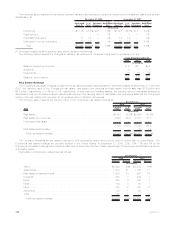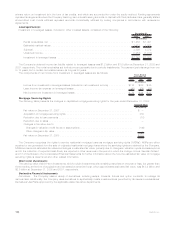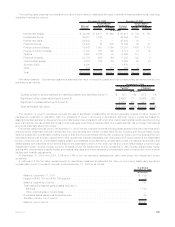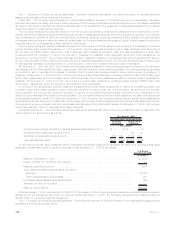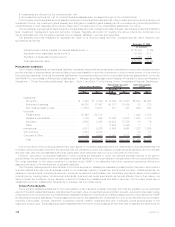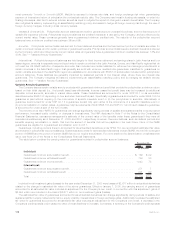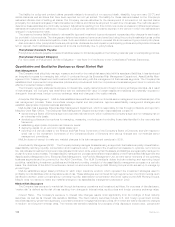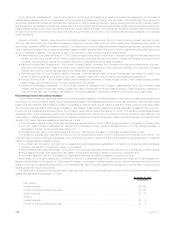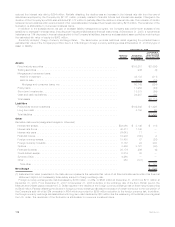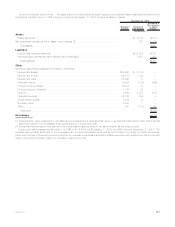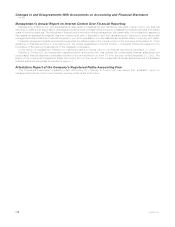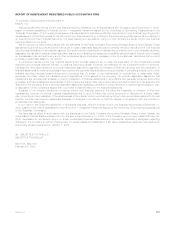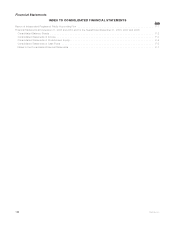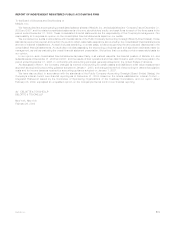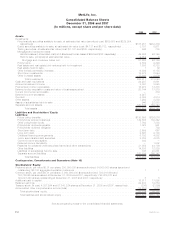MetLife 2008 Annual Report Download - page 115
Download and view the complete annual report
Please find page 115 of the 2008 MetLife annual report below. You can navigate through the pages in the report by either clicking on the pages listed below, or by using the keyword search tool below to find specific information within the annual report.The liability for policy and contract claims generally relates to incurred but not reported death, disability, long-term care (“LTC”) and
dental claims as well as claims that have been reported but not yet settled. The liability for these claims is based on the Company’s
estimated ultimate cost of settling all claims. The Company derives estimates for the development of incurred but not reported claims
principally from actuarial analyses of historical patterns of claims and claims development for each line of business. The methods used to
determine these estimates are continually reviewed. Adjustments resulting from this continuous review process and differences between
estimates and payments for claims are recognized in policyholder benefits and claims expense in the period in which the estimates are
changed or payments are made.
The unearned revenue liability relates to universal life-type and investment-type products and represents policy charges for services to
be provided in future periods. The charges are deferred as unearned revenue and amortized using the product’s estimated gross profits
and margins, similar to deferred acquisition costs. Such amortization is recorded in universal life and investment-type product policy fees.
Also included in other policyholder funds are policyholder dividends due and unpaid on participating policies and policyholder dividends
left on deposit. Such liabilities are presented at amounts contractually due to policyholders.
Policyholder Dividends Payable
Policyholder dividends payable consists of liabilities related to dividends payable in the following calendar year on participating policies.
Policyholder Dividend Obligation
FormoredetailonPolicyholderDividendObligation—seeNote9oftheNotestotheConsolidatedFinancialStatements.
Quantitative and Qualitative Disclosures About Market Risk
Risk Management
The Company must effectively manage, measure and monitor the market risk associated with its assets and liabilities. It has developed
an integrated process for managing risk, which it conducts through its Enterprise Risk Management Department, Asset/Liability Man-
agement Unit, Treasury Department and Investment Department along with the management of the business segments. The Company has
established and implemented comprehensive policies and procedures at both the corporate and business segment level to minimize the
effects of potential market volatility.
The Company regularly analyzes its exposure to interest rate, equity market price and foreign currency exchange rate risks. As a result
of that analysis, the Company has determined that the estimated fair value of certain assets and liabilities are materially exposed to
changes in interest rates, foreign currency exchange rates and changes in the equity markets.
Enterprise Risk Management. MetLife has established several financial and non-financial senior management committees as part of its
risk management process. These committees manage capital and risk positions, approve asset/liability management strategies and
establish appropriate corporate business standards.
MetLife also has a separate Enterprise Risk Management Department, which is responsible for risk throughout MetLife and reports to
MetLife’s Chief Risk Officer. The Enterprise Risk Management Department’s primary responsibilities consist of:
• implementing a Board of Directors approved corporate risk framework, which outlines the Company’s approach for managing risk on
an enterprise-wide basis;
• developing policies and procedures for managing, measuring, monitoring and controlling those risks identified in the corporate risk
framework;
• establishing appropriate corporate risk tolerance levels;
• deploying capital on an economic capital basis; and
• reporting on a periodic basis to the Finance and Risk Policy Committee of the Company’s Board of Directors, and with respect to
credit risk to the Investment Committee of the Company’s Board of Directors and various financial and non-financial senior
management committees.
MetLife does not expect to make any material changes to its risk management practices in 2009.
Asset/Liability Management(ALM). The Company actively manages its assets using an approach that balances quality, diversification,
asset/liability matching, liquidity, concentration and investment return. The goals of the investment process are to optimize, net of income
tax, risk-adjusted investment income and risk-adjusted total return while ensuring that the assets and liabilities are reasonably managed on
a cash flow and duration basis. The asset/liability management process is the shared responsibility of the Financial Risk Management and
Asset/Liability Management Unit, Enterprise Risk Management, the Portfolio Management Unit, and the senior members of the operating
business segments and is governed by the ALM Committee. The ALM Committee’s duties include reviewing and approving target
portfolios, establishing investment guidelines and limits and providing oversight of the asset/liability management process on a periodic
basis. The directives of the ALM Committee are carried out and monitored through ALM Working Groups which are set up to manage by
product type.
MetLife establishes target asset portfolios for each major insurance product, which represent the investment strategies used to
profitably fund its liabilities within acceptable levels of risk. These strategies are monitored through regular review of portfolio metrics, such
as effective duration, yield curve sensitivity, convexity, liquidity, asset sector concentration and credit quality by the ALM Working Groups.
MetLife does not expect to make any material changes to its asset/liability management practices in 2009.
Market Risk Exposures
The Company has exposure to market risk through its insurance operations and investment activities. For purposes of this disclosure,
“market risk” is defined as the risk of loss resulting from changes in interest rates, equity prices and foreign currency exchange rates.
Interest Rates. The Company’s exposure to interest rate changes results most significantly from its holdings of fixed maturity
securities, as well as its interest rate sensitive liabilities. The fixed maturity securities include U.S. and foreign government bonds,
securities issued by government agencies, corporate bonds and mortgage-backed securities, all of which are mainly exposed to changes
in medium- and long-term interest rates. The interest rate sensitive liabilities for purposes of this disclosure include debt, policyholder
112 MetLife, Inc.


